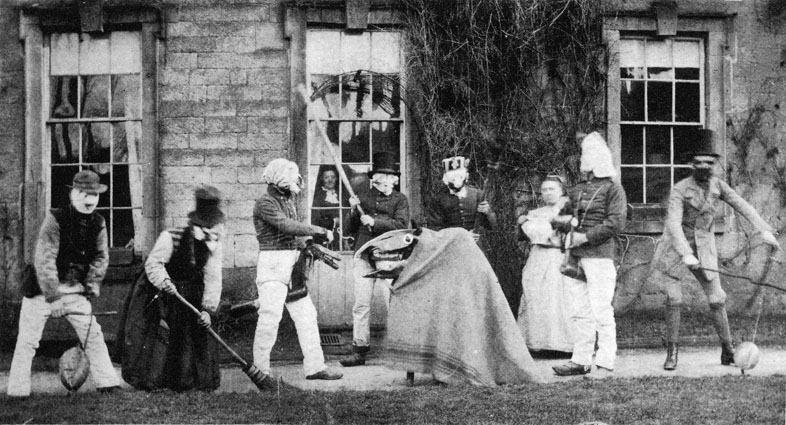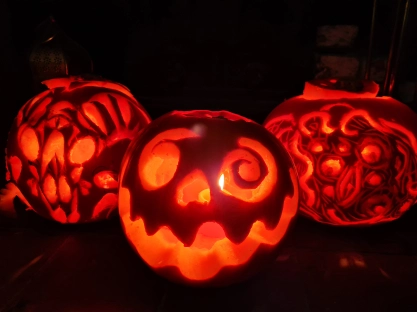
Midwinter may seem like a strange time to look at the British folk tradition of the hobby horse. Thanks to hugely popular events such as the Padstow ‘Obby ‘Oss festival, the tradition is often associated with May Day celebrations in the popular imagination.
However, there is another, possibly older, tradition involving the hobby horse that takes place at Midwinter and across the twelve days of Christmas.
What is a hobby horse?
Firstly, it is helpful to outline what a hobby horse is in folk tradition (and what it is not).
Starting with language, the word ‘hobby‘ was originally an old English term that just meant a small, slow horse.1
The hobby horse of folklore was first recorded in Britain in a fourteenth century Welsh poem Gruffud Gryg in which it is described as a novelty, possibly originating in England. Further references can be found in the 1460/61 London Accounts for St Andrew Hubbard ‘to Mayers child for drawnsynge wt ye hobye hors’. While in 1504 a Cornish Play, Beunas Meriask, uses the English term for the hobby horse, which may point at an origin outside Cornwall.2
Over time the term continued to develop and by the eighteenth-century it was used to describe someone’s interest or pastime, such as in the 1759 novel, Tristram Shandy, by Lawrence Sterne.

However, in folkloric terms it usually describes a horse-based costume worn during certain seasonal celebrations, such as May Day games and Midwinter. In these festivities, the hobby horse might feature along with Morris dancers and mummers’ plays. The hobby horse costume itself could take on any number of forms. The Dictionary of English Folklore outlines the main types of hobby horse as follows:3
The tourney horse is the most easily recognisable, this type of hobby horse still pops up in light entertainment shows and is a popular fancy dress costume. The name derives from ‘tournament‘, and it is thought this type of horse may have developed as a result of jousting tournaments, which were introduced to England in the twelfth century .
The ‘rider’ wears the horse as a costume, this usually meant donning an oval shaped wooden or basketwork frame, with a horse’s head at the front and a tail at the back. Often the horse’s head would have snapping jaws. The structure was held up by braces or straps and the rider’s head and upper body was visible. A skirt encompassed the hobby horse and disguised the rider’s legs (although a long cloak may have been worn in earlier versions).
Mast horse. This has a much simpler, primitive design than the tourney horse. It is usually made up of a long pole, wrapped in a sheet and topped off with a horse’s skull (carved or real). In this form, the person holding the mast horse is completely hidden beneath the sheet.

Sieve horses are a Lincolnshire variant, often made out of farm equipment such as a large sieve. The wearer stands hidden within the sieve, the costume has a horse’s head and tail attached.
Stick horses are beloved of children and hobby horsing enthusiasts, the stick horse is, quite simply, a stick with a horse’s head on top, and is ridden astride. While this type of horse does feature in the Finnish Hobby Horse Championships, it is not known to have featured in any British folkloric traditions.
It is worth noting that some hobby horses are not easily categorised within the above types. The famous ‘Obby ‘Oss festival in Padstow features two circular hobby horses, covered in an oilskin, with only the head of the person showing. The horse’s head has snapping jaws, and it has a horse’s tail, but unlike other hobby horses, it also sports a devilish looking mask in the middle! 4

The Hobby horse as a midwinter tradition
The hobby horse may seem to be intrinsically linked to May Day, with famous examples being found in Padstow and Minehead in Cornwall, but researchers such as Violet Alford and E.C. Cawte proposed that they in fact may be originally Midwinter traditions. They emphasised that in Early Modern England the hobby horse did not have any specific seasonal link but was brought out whenever there were festivities.5 The use of hobby horses in Midwinter is supported by a number of records.
Helping the poor
Church records from the mid fifteenth to the seventeenth century show that a hobby horse was often part of the church’s midwinter celebrations. It was a festive way to raise money for the poor of the parish during the hard winter months. Accounts from 1529, show that money raised was also used to buy candles for the church and maintain the hobby horse itself. 6
Entertaining the rich
During the sixteenth century, Twelve Days celebrations, running from Christmas Day to Epiphany on 6 January, were popular both at Court and amongst the gentry. The revels were led by the Lord of Misrule, and typical celebrations featured a ‘boy bishop,’ wassailing and much merriment.
Court records, for 1551/2, show that the boy king Edward VI, had thirteen hobby horses as part of his Twelve Days celebrations. Elizabeth I was also a fan, engaging several sets of hobby horses for her Christmas festivities. Wealthy households would engage travelling players to perform hobby horse antics for their midwinter entertainments, and examples exist from Essex from the 1570’s, and the 1630’s.7,8
An image from 1620, showing the Thames at Richmond, shows that hobby horses used for collecting alms and courtly celebrations were most likely of the tourney variety.
Foretelling the future

Another type of winter tradition is the visiting horse. This is a mast type horse carried from house to house to bring good luck and, sometimes, to foretell the future.
A rural Christmas Tradition from Northeast Kent saw farm labourers roaming from house to house carrying a mast horse called The Hooden Horse. The Hooden Horse was made up of a long pole, topped with a carved horses head, carried by a man covered by a dark coloured sheet. It travels from house to house causing merriment and mayhem and was attended by a retinue including a man with a whip, a rider, and a ‘Mollie’ (a man dressed as a woman) carrying a broom. (Much has been written of the significance of the Mollie man/woman character in this, and other hobby horse festivities).
A similar tradition exists in South Wales in the form of the Mari Lwyd (the grey mare) that visits houses in the community during Christmas and the New Year. The horse and its attendants approach a house, sing to earn admittance, the inhabitants sing a verse in response, each parrying the other until the horse is finally allowed to enter, bringing with it good luck for the new year.
On the Isle of Man, another mast horse, the Laare Vane (the white mare) visits houses on New Year’s Eve, along with its attendants, one of which is a fiddler. The horse causes mayhem by chasing the girls, until it catches one of them. She dons a disguise, then the Laare Vane performs a stick dance for her. The ceremony ends with the beheading of the fiddler (not literally, of course). The ‘head’ is then placed in the lap of the Laare Vane, where it makes predictions about the coming year.
Industrial areas such as the borders between Nottingham, Yorkshire and Derbyshire also have similar visiting horse Christmas traditions in the form of the ‘Old Horse.’

Flogging an old (hobby) horse
Folklorists have long debated just how old the hobby horse tradition is. For early twentieth century folklorists, such as Sir James Frazer and Lord and Lady Raglan, the focus was on forging an unbroken link deep into Britain’s pre-Christian past. This was based on the false assumption that rural communities were culturally static and retained their ancient customs unchanged, to the chagrin of the Church. Much weight was also placed on texts from early church fathers that denounced traditions involving animal disguises, such as the Penetentials, written in the seventh century by the Archbishop of Canterbury, Theodore of Tarsus. 9
Researchers in the 1960s, began to challenge this view. They discovered that the oft quoted section from the Penetantials, was actually marginalia, inserted by a French or German scribe two hundred years later, so may not, in fact, reflect the concerns of the seventh century English church fathers.10
Archivists demonstrated that hobby horses only began to appear in the records from the fourteenth century onwards. Surviving records also make it clear that far from condemning hobby horses as pagan survivals, the early modern church was actively using them as a mechanism for fund-raising. 11,12
It is also hard to link up the activities of the several types of hobby horses to create a unified tradition. They are separated by both time and purpose if the records are anything to go by.
Nevertheless, one traditional hobby horse may hold some echoes of the ancient past. The Laare Vane appears in the records from the early nineteenth century, but Ronald Hutton sees this tradition, with its focus on prophecies and severed heads, as potentially harking back to prehistoric Celtic severed head cults.12
In conclusion
The hobby horse may not be provably ancient in origin, but it certainly has a long and distinguished pedigree as a British midwinter tradition. It is also, far from a bygone tradition, having undergone a revival in recent decades. The Mari Lwyd and the Laare Vane and their attendants, still caper through the streets of South Wales and the Isle of Man at Midwinter, bringing with them wild revels, good luck, and just maybe, a peek into the future.

Sources
Hutton, Ronald, The Stations of the Sun, 1997
Simpson, Jacqueline, Roud, Steve, The Dictionary of English Folklore, 2000
Notes
[1] Hobby horse Hobby horse – Wikipedia
[2] The Dictionary of English Folklored by Jacqueline Simpson & Steve Round
[3] Ibid
[4] The Stations of the Sun by Ronald Hutton
[5] Ibid
[6] The Dictionary of English Folklored by Jacqueline Simpson & Steve Round
[7] Ibid
[8] The Stations of the Sun by Ronald Hutton
[9] Ibid
[10] Ibid
[11] Ibid
[12] Ibid
[13] The Dictionary of English Folklored by Jacqueline Simpson & Steve Round





Leave a Reply